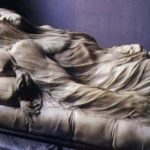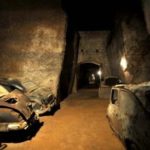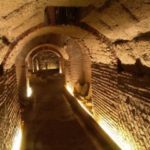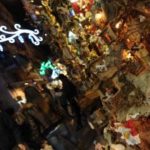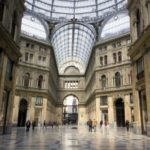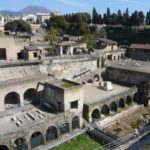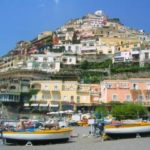The Castel Nuovo or Angevin occurs irregularly trapezoidal in plan and consists of five cylindrical towers, four coated piperno and tuff, and crowned with battlements corbels. The three towers on the side facing the ground, where is the entrance, are the towers “St. George”, “Middle” and “Guard” (from left to right), while the two on the side facing the sea take the name of the tower “Gold” and tower “Beverello” (again from left to right). The castle is surrounded by a moat and towers rise on large bases in slope, in which the texture of the stone blocks assumes complex designs, recalling examples Catalans. On the side of the castle facing the sea overlooking the back wall of the “Palatine Chapel”, or church of “San Sebastian” or “Santa Barbara”, the only surviving element of the Angevin castle fourteenth century, although damaged in the earthquake of 1456 and later restored. The façade overlooking the interior courtyard features a Renaissance portal with reliefs by Andrea Aquila and Francesco Laurana and a rose window, rebuilt in the Aragonese period. Inside, lit by tall and narrow Gothic windows are preserved only scant remains of the original painted decoration, by Maso di Banco and a ciborium by Jacopo della Pila, dated to the end of the fifteenth century. A spiral staircase accessible from a door on the left allowed to rise to the “hall of the Barons.” The interior was frescoed by Giotto in 1330 but the content of this cycle of frescoes is almost entirely lost even if it is described in the verses of an anonymous author in a collection of sonnets of 1350. Between the two towers defending the entrance towers (“Middle” and “Guard”) was erected a triumphal arch in marble, intended to celebrate the memory of the entry of King Alfonso in the capital. The work is inspired by Roman triumphal arches. A lower arch, framed by paired Corinthian columns, features on the sides of the passage reliefs depicting Alfonso among the relatives, and the princes and great officers of the kingdom, the attic relief depicting the Triumph of Alfonso. A second arc is superimposed on the first, with twin Ionic columns, and was meant to house the statue of the king. On the top the statues of the four virtues (Temperance, Justice, Fortitude and Magnanimity), placed in the niches, surmounted by a crown-shaped pediment, with figures of rivers and on top of the statue of St. Michael. The sculptures are attributed to important artists of the time: Guillem Sagrera, Gagini, Isaiah from Pisa and Francesco Laurana. The “Sala dei Baroni” is the main hall of the Angevin. It takes its name from the fact that in 1487 some of the barons who conspired against Ferrante I of Aragon were invited by him in this room to celebrate the wedding of her niece. In fact it was a trap: the barons were arrested and some of them put to death. Placed at the corner of the tower “Beverello”, between the north side and the east side, facing the sea, the large hall (26 mx 28 m), by Guillem Sagrera, is covered by a large octagonal resting on strombature angular and equipped with ribs that form a star design. On the side facing the sea, between two cross windows open to the outside, there is a large fireplace, surmounted by two stages for musicians. Among the works of art still in the room is a marble portal of Gagini two-faced, two bas-reliefs on which are depicted the triumphal procession of Alfonso of Aragon and the entrance of the King in the castle, a portal through which Catalan leads to the Chamber of Angels. A special mention deserves the spiral staircase in piperno, now unusable, which leads to the upper terraces. The floor of the room was decorated with blue and white glazed earthenware, from Valencia. The room, although damaged by fire in 1919, but remained the only castle that still retains its original appearance. Until 2006 it hosted the meeting of the council of Naples. Of course, like any self-respecting castle, the Angevin has extensive underground and gloomy prisons, there is then a cell called “cell of the Crocodile,” which, according to legend, it fed the enemy of kings and the star-crossed lovers of the queen Giovanna.




